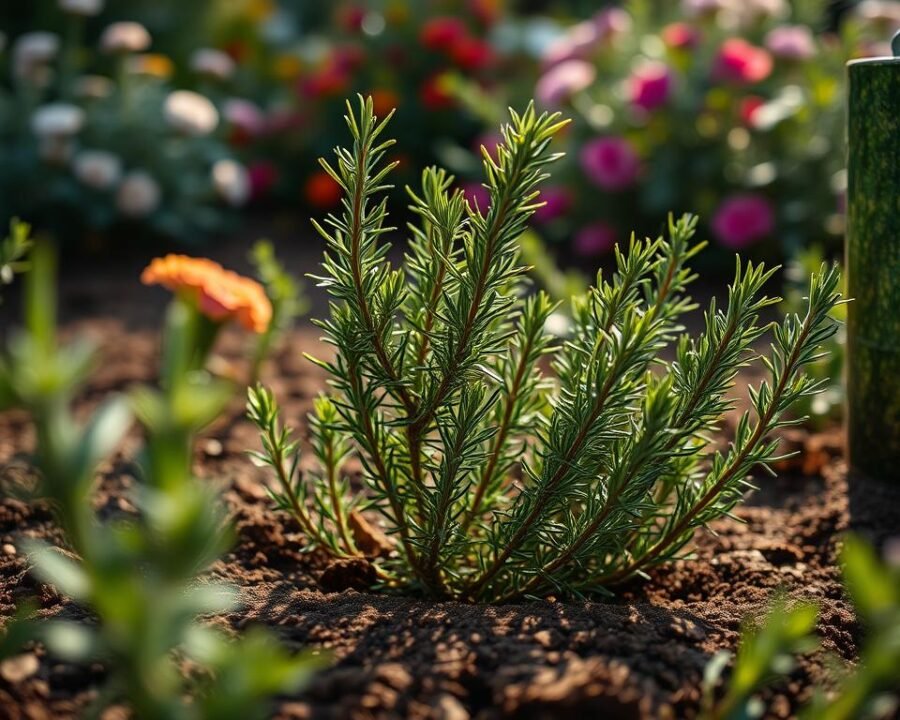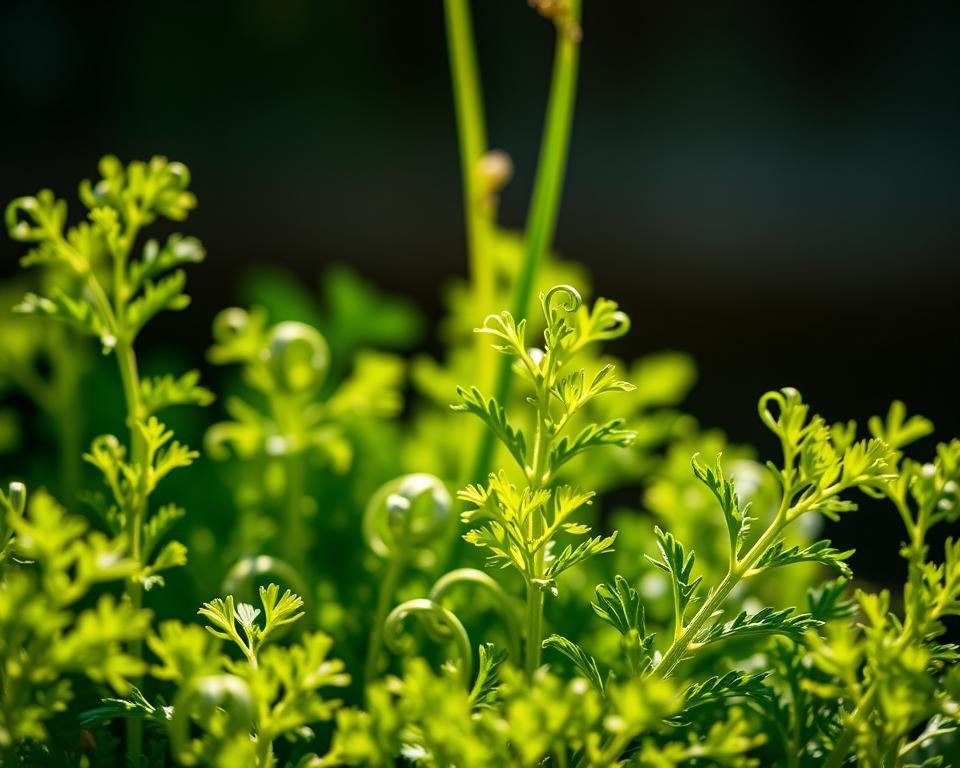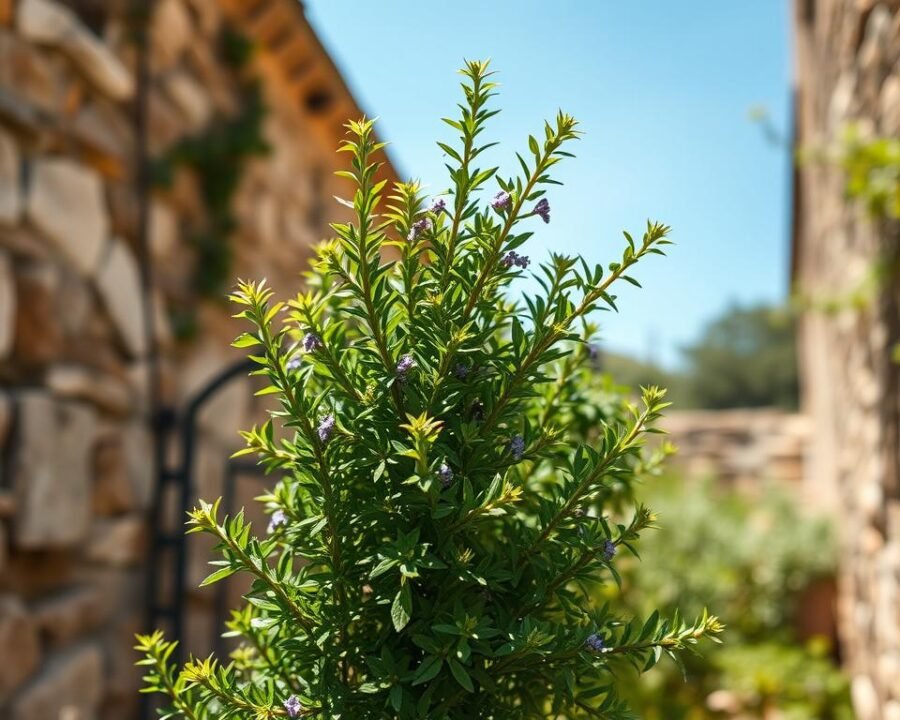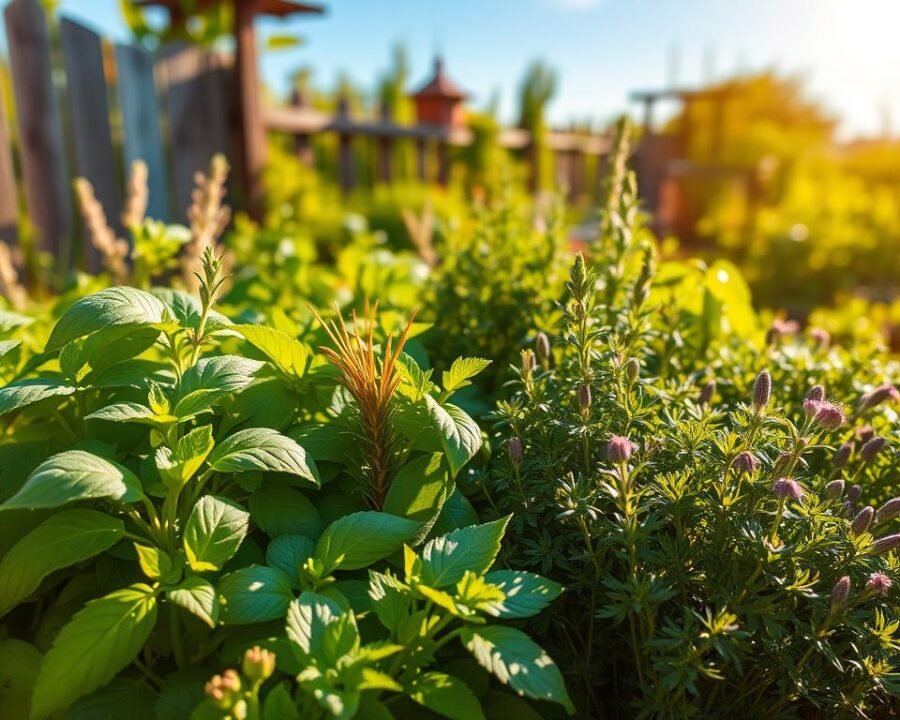There’s something magical about plucking fresh herbs right from your garden. The scent of basil after a summer rain or the crisp bite of mint in your tea transforms ordinary moments into small delights. For beginners, these plants are forgiving gateways into gardening—offering quick rewards with minimal fuss.
Beyond flavor, herbs bring life to any space. They thrive in pots on balconies or windowsills, proving you don’t need acres to cultivate beauty. From vibrant purple sage to trailing rosemary, each variety adds texture and color to your green sanctuary.
We’ve curated a list of top performers based on decades of horticultural expertise. Whether you crave culinary flair or visual charm, there’s a perfect match waiting to sprout in your garden.
Key Takeaways
- Herbs are ideal starter plants for new gardeners.
- They enhance both meals and outdoor spaces.
- Compact growth suits small areas like balconies.
- Our selection combines beauty and practicality.
- Expert-backed choices ensure success.
Why Growing Herbs Elevates Your Garden (and Kitchen)
Growing herbs at home bridges the gap between your garden and kitchen effortlessly. These versatile plants serve as both decorative accents and flavor boosters. A compact herb garden thrives in pots, making it ideal for balconies or windowsills.
Fresh herbs enhance flavors in soups, salads, and stews instantly. Unlike store-bought options, homegrown sprigs retain peak aroma and nutrients. Regular harvesting actually encourages fuller growth—snip often for lush results.
Cost savings add up quickly. A single plant like basil yields months of harvests for less than supermarket bundles. Plus, you avoid plastic waste from pre-packaged herbs.
Health perks are undeniable. Studies show fresh herbs pack phytonutrients and antioxidants. For example, oregano has higher levels than many fruits. Even tending to these plants reduces stress—their scents naturally soothe the mind.
From peppermint’s cooling leaves to thyme’s earthy notes, each variety brings unique charm. Whether you crave culinary flair or a sensory retreat, herbs deliver on every front.
The Best Garden Herb You Need to Try: Our Top Picks
Few plants offer as much versatility as these three foundational herbs. Whether adding zest to dishes or fragrance to outdoor spaces, basil, rosemary, and mint deliver unmatched value. Beginners will appreciate their forgiving nature and rapid rewards.
Basil: The Versatile Favorite
Basil’s sweet to spicy varieties, like classic Genovese or Thai, star in global cuisines. This annual thrives in warm soil and full sun, producing abundant leaves for pesto, salads, and garnishes. Regular trimming encourages bushier growth.
Rosemary: Aromatic and Hardy
Rosemary survives frost when moved indoors, making it a resilient perennial. Its needle-like leaves infuse meats and roasted veggies with piney depth. Drought-tolerant and sun-loving, it’s ideal for forgetful gardeners.
Mint: Refreshing and Prolific
Mint spreads rapidly, requiring containers to curb its enthusiasm. Peppermint and spearmint varieties refresh teas and cocktails. Plant in partial shade for vibrant foliage.
| Herb | Type | Key Trait | Ideal Use |
|---|---|---|---|
| Basil | Annual | Heat-loving | Culinary dishes |
| Rosemary | Perennial | Drought-resistant | Roasts & aromatics |
| Mint | Perennial | Fast-spreading | Beverages & desserts |
These herbs grow well in containers or garden beds. Each plant suits different needs, from basil’s culinary flair to rosemary’s low-maintenance charm. Start with these to build a thriving, flavorful space.
Basil: The King of Culinary Herbs
No herb captures the essence of summer quite like basil. Its sweet, peppery leaves elevate everything from caprese salads to stir-fries. Whether grown in pots or garden beds, this heat-loving annual thrives with minimal fuss.
Growing Conditions: Sun and Warmth
Basil demands two things: plenty of sun and warm soil. Plant seeds or seedlings when temperatures hit 70°F+. Soak seeds overnight to speed up germination. For bushier plants, pinch stems back once they reach 6 inches tall.
Pair basil with tomatoes—they’re companion plants that enhance each other’s growth. Avoid overwatering; well-drained soil prevents root rot.
Uses: From Pesto to Salads
Fresh basil shines in dishes worldwide. Genovese basil stars in Italian pesto (try 2 cups leaves + ½ cup olive oil). Thai basil adds licorice notes to curries. For a simple upgrade, toss leaves into salads or atop pizzas.
“Basil’s flavor peaks when harvested just before flowering—that’s when oils are most concentrated.”
Health Benefits: Packed with Antioxidants
Beyond flavor, basil boasts 150+ polyphenols. It’s rich in vitamin K for bone health and magnesium for stress relief. Studies suggest its essential oils may reduce inflammation.
- Vitamin K: 28% daily value per ½ cup
- Antioxidants: Higher levels than some berries
- Easy to grow: A single plant yields months of harvests
Rosemary: A Fragrant Garden Staple
Rosemary brings Mediterranean charm to any space with its aromatic leaves. This hardy plant originated in rocky coastal regions, thriving where other herbs struggle. Its needle-like foliage releases a piney scent when brushed, perfect for pathways or container gardens.

Thrives in Dry, Sunny Spots
Rosemary loves full sun and well-drained soil. Gravel mulch mimics its native habitat, preventing root rot. In colder zones (below 7), wrap plants in horticultural fleece during winter. Blue flowers in spring attract bees, boosting pollination nearby.
Culinary Pairings: Meats and Roasts
Fresh sprigs elevate lamb, chicken, and roasted veggies. Dried rosemary intensifies in flavor—ideal for rubs and infused oils. Janet Loughrey notes:
“Drying concentrates rosemary’s essential oils, deepening its earthy notes.”
| Form | Best Uses | Flavor Profile |
|---|---|---|
| Fresh | Marinades, garnishes | Bright, pine-like |
| Dried | Spice blends, bread | Robust, woody |
Low-Maintenance Perennial
This drought-tolerant herb needs minimal care:
- Prune lightly in spring to maintain shape.
- Water only when soil is dry to the touch.
- Harvest year-round in mild climates.
Whether in a garden bed or pot, rosemary delivers beauty and flavor across seasons.
Mint: Easy-Grow Flavor Powerhouse
With over 500 varieties, mint offers endless possibilities for flavor and fragrance. This resilient herb thrives in partial shade, making it ideal for balconies or kitchen windowsills. Its rapid growth and cooling aroma make it a favorite among gardeners and chefs alike.
Container Gardening Tips
Mint spreads aggressively, so planting in containers prevents it from overtaking beds. Use self-watering pots with drainage holes to maintain moisture without soggy roots. For wilted stems, soak them overnight in water to revive their crispness.
“Mint’s roots need room to breathe—choose a breathable grow bag for optimal aeration.”
Varieties: Peppermint to Chocolate Mint
Spearmint’s mild sweetness shines in tea, while peppermint’s bold flavor energizes cocktails. Chocolate mint adds a dessert-like twist to baked goods. All varieties share mint’s signature vigor but differ in leaf shape and intensity.
- Spearmint: Gentle flavor, ideal for salads.
- Peppermint: High menthol content, perfect for teas.
- Chocolate Mint: Subtle cocoa undertones for desserts.
Uses: Teas, Cocktails, and More
Crush fresh leaves into mojitos or steep them for digestive tea. Mint’s natural anti-inflammatory properties also soothe nausea. Pair it with companion plants like parsley to deter pests naturally.
| Variety | Best Use | Growth Habit |
|---|---|---|
| Spearmint | Culinary | Spreading |
| Peppermint | Medicinal | Upright |
| Chocolate Mint | Desserts | Trailing |
Parsley: The Biennial All-Rounder
Often overlooked, parsley delivers flavor and nutrition in equal measure. This versatile herb brightens salads, soups, and sauces while offering remarkable health perks. Unlike annuals, its biennial nature means it thrives for two years—flowering in the second spring.

Rich in Vitamins A and C
Parsley’s leaves contain triple the vitamin C of oranges. A ½-cup serving also meets 100% of daily vitamin K needs. Its antioxidants support immune function and skin health.
Slow Germination? Soak Seeds Overnight
Seeds can take 14–28 days to sprout. Speed up the process by soaking them in warm water for 24 hours before planting. Use fish emulsion fertilizer every three weeks for lush growth.
Garnish and Digestive Aid
Flat-leaf parsley’s robust flavor suits cooked dishes, while curly varieties garnish plates beautifully. Both types aid digestion—steep leaves in hot water for a detox tea.
| Type | Best Uses | Germination Time |
|---|---|---|
| Curly | Garnishes, teas | 21–28 days |
| Flat-leaf | Tabbouleh, soups | 14–21 days |
Try adding chopped flat-leaf parsley to tabbouleh for a fresh twist. Its chlorophyll content may even help detoxify heavy metals naturally.
Thyme: Earthy and Resilient
Ancient Greeks valued thyme for both flavor and medicinal properties. Today, this woody perennial remains a garden favorite, thriving in rocky soils where other herbs falter. Its tiny leaves pack intense aroma, perfect for elevating dishes or creating fragrant ground cover.
Perfect for Rock Gardens
Creeping thyme forms dense mats that withstand foot traffic, ideal between stepping stones. It survives -20°F in well-drained soil, needing just full sun and occasional watering. Silver-edged varieties like ‘Archer’s Gold’ add visual contrast to alpine plantings.
Flavor Profiles: Lemon to Caraway
Over 350 cultivars offer diverse tastes:
- Lemon thyme: Citrus notes for fish and poultry
- Caraway thyme: Anise-like flavor for roasted root vegetables
- Common thyme: Classic earthy base for stocks and stews
“Thyme is the backbone of Herbes de Provence—its camphor notes balance lavender’s sweetness.”
Medicinal and Culinary Uses
This herb shines beyond the garden:
| Application | Method | Benefit |
|---|---|---|
| Culinary | Whole sprigs in roasting pans | Infuses meats with depth |
| Medicinal | Steeped tea for coughs | Antimicrobial thymol content |
| Beekeeping | Thyme honey production | Distinctive herbal sweetness |
Propagate easily via stem cuttings in spring. For essential oil extraction, harvest just before flowering when oil concentration peaks. Whether garnishing pizza or soothing sore throats, thyme delivers remarkable versatility.
Oregano: Mediterranean Essential
A staple in Mediterranean kitchens, oregano brings bold flavor and resilience to any herb collection. This sun-loving plant thrives with minimal care, offering aromatic leaves and delicate flowers. Whether for pizza toppings or natural pest control, it earns its place among essential herbs.

Sun-Loving and Drought-Tolerant
Greek oregano (Origanum vulgare hirtum) packs stronger flavor than common varieties. Both types demand full sun and well-drained soil. When stems reach 10cm, pinch vertical growth to encourage bushiness. This technique maximizes leaf production while preventing legginess.
Lacewings flock to its tiny white flowers, making oregano a natural pest-control ally. These beneficial insects devour aphids, protecting nearby peppers and tomatoes—ideal companion plants.
Pizza, Pasta, and Pollinators
Dried oregano concentrates its earthy, slightly bitter notes—perfect for:
- Tomato-based sauces: 1 tsp dried = 1 tbsp fresh
- Herb blends: Combine with basil and thyme
- DIY drying: Hang bunches in paper bags for 2 weeks
“Oregano’s carvacrol compound shows anti-inflammatory effects comparable to some medications.”
Indoor/Outdoor Flexibility
This mint family member adapts to containers or garden beds. In colder zones, plant in pots for easy winter relocation. Outdoors, it survives temperatures down to 10°F with mulch protection.
| Variety | Flavor | Best Use |
|---|---|---|
| Greek | Intense, spicy | Cooking |
| Golden | Mild, citrusy | Ornamental |
For year-round harvests, grow both types. Their versatility spans from garnishing grilled meats to brewing digestive teas.
Chives: Delicate Onion Flavor
These slender green stalks pack more than just flavor—they’re a gardener’s multitasking marvel. Chives thrive in containers or garden beds, offering mild onion notes and vibrant purple flowers. Their adaptability makes them perfect for urban balconies or kitchen windowsills.
Edible Flowers for Salads
Chive blossoms aren’t just pretty—they’re edible. Toss them into salads for color or infuse vinegar for a floral twist. Here’s how:
- Fill a jar with clean, dry blossoms
- Cover with warm apple cider vinegar
- Steep for 2 weeks, then strain
The result? A pink-hued dressing base with subtle allium notes. These flowers also attract predatory wasps, natural pest controllers.
Divide and Multiply Easily
Every 3 years, dig up clumps and separate them into smaller plants. This prevents overcrowding and boosts productivity. Use grass clippings as mulch to retain moisture around new divisions.
Ideal for Small Spaces
Chives excel in confined areas:
- Window boxes: Pair with pansies for color contrast
- Indoor pots: Place near sunny windows
- Vertical gardens: Their shallow roots adapt well
Like garlic, they contain allicin—a compound linked to cholesterol reduction. For bolder flavor, try garlic chives (Allium tuberosum) with flat leaves and white blooms.
Conclusion: Start Your Herb Garden Today
Flavorful and low-maintenance, these herbs make gardening accessible. Basil, rosemary, and mint offer quick wins for beginners. Pair them with thyme or oregano for a resilient herb garden that thrives in pots or beds.
Studies show 85% of first-time gardeners succeed with starter plants like chives and parsley. For curated varieties, Proven Winners provides disease-resistant options. Their guides simplify how herbs grow in different climates.
Ready to begin? Download our free herb journal to track progress. Whether on a windowsill or patio, your garden journey starts with just a few best herbs. Happy planting!
